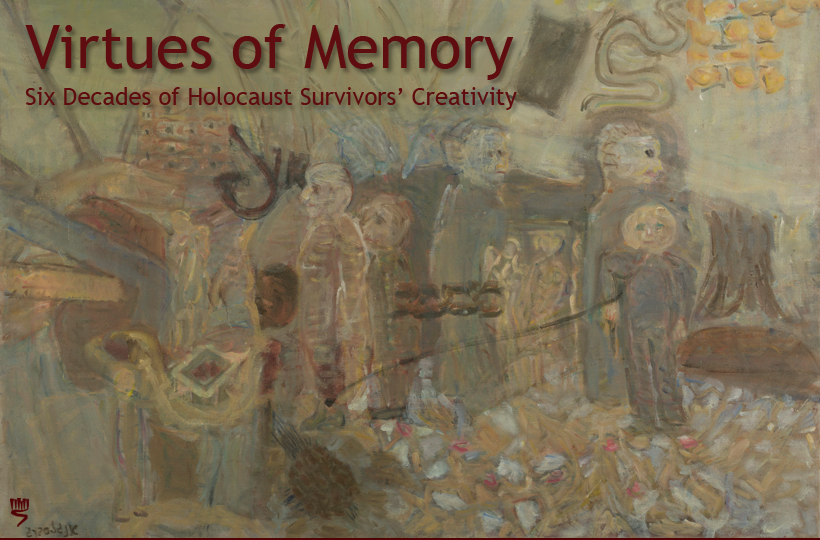
Virtues of Memory: Six Decades of Holocaust Survivors’ Creativity
Tomorrow a new exhibition will open at Yad Vashem. Curator of the exhibition Yehudit Shendar, writes about its significance in Haaretz:
A powerful visual voice
Sixty-five years after the Holocaust, the weight of memory continues to be borne by the survivors. Over the years, many have found ways to unburden themselves, some by means of the written word, others through verbal expression and a number by means of visual images - through film and art. When entering the new exhibition "Virtues of Memory" at Yad Vashem, one is struck by the colorfulness of the mosaic of artworks on display. The exhibit showcases works by Holocaust survivors grappling with memories from 65 years ago and beyond.
While each artist confronts a singular experience, the exhibition reveals recurring themes and modes of expression. Particularly striking is the depiction in color of images long etched into the collective memory in black and white, which reflected photographic developments at the time. Whether abstract or natural, amateur or professional, the reality experienced by the survivors is expressed in natural hues, also incorporating an expressionist element of the most intimate emotions of those who actually experienced the horrors.
The fact that art was created after the Holocaust in and of itself is noteworthy. Shortly after the war there were those, such as the German-Jewish philosopher Theodor Adorno, who raised the question of the legitimacy of artistic expression after one has witnessed the atrocities of human nature. Poetry, he famously maintained, cannot exist in a world that also contained Auschwitz.
This discussion continues today. Are movies, dance, theater and other artistic expressions appropriate outlets for anyone wishing to grapple with the subject of the Holocaust? Or are the only people entitled to use these media, as recently suggested by American author Cynthia Ozick, the survivors themselves?
In the meantime, though, we have the opportunity to view these works by the "witness-survivors," as the late French philosopher Jean-Francois Lyotard called them, "who testif[y] to the incomprehensible, the indescribable." Indeed, the unique nature of the Shoah challenged the ability of anyone to describe or relate to it, including those for whom words were not an option. "How could I tell of a world that has been destroyed?" said artist-survivor Samuel Bak, who himself has a painting on display in the show. "How could I reach out for those elusive and indefinable memories? All these concerns became the concerns of my art."
During the five decades since its founding, Yad Vashem has collected hundreds of artworks from the brushes and chisels of survivors. Together they comprise a powerful body of visual testimony, one that complements the written and oral evidence provided over the years by so many of those who witnessed the events of the Holocaust first hand. Those who committed their memories to drawing paper or canvas, or by sculpting in stone or carving in wood, in a language that was visual rather than verbal, had much to say.
"Virtues of Memory: Six Decades of Holocaust Survivors' Creativity," which opens at Yad Vashem on Holocaust Remembrance Day, April 12, is the manifestation of this collection of artistic expression. The exhibition brings together the work of close to 300 Holocaust survivors from all over the world, made since the end of the war. Each of them has worked in seclusion, yet together they form a "Holocaust school of art" that surely deserves further study. The members of this unique "school" share similar themes and modes of expression. While each faced a succession of unique experiences, in their art, they highlight the dramatic junctions that mirror the annals of the Jewish people during the war years. The crematoria, the deportations, the families torn asunder and the burning, lost world - these are not symbols, but rather depictions, of the real world during those tremulous years.
In contrast to Yad Vashem's Museum of Holocaust Art, which displays art created during the Shoah itself, the new exhibition and its accompanying extensive catalog present the work of survivors. While the former records events in real time, post-Holocaust art is a personal system of remembrance that creates a legacy for others. In that sense one may say that the show is not solely an art exhibit, but an exhibit of memory. Images that were seared into the artists' memories are being transferred to ours.
Art is that most subjective of creative forms, but in the survivors' art we glimpse a truth that we - being removed from the events - may not otherwise be able to fathom. Each of the works is the voice of an individual; combined, they present a powerful ensemble, whose commanding expression of truth and memory calls out to us all.
Yehudit Shen-Dar is deputy director of the museums division and senior art curator at Yad Vashem









